Complete guide: Add WooCommerce minimum & maximum quantity
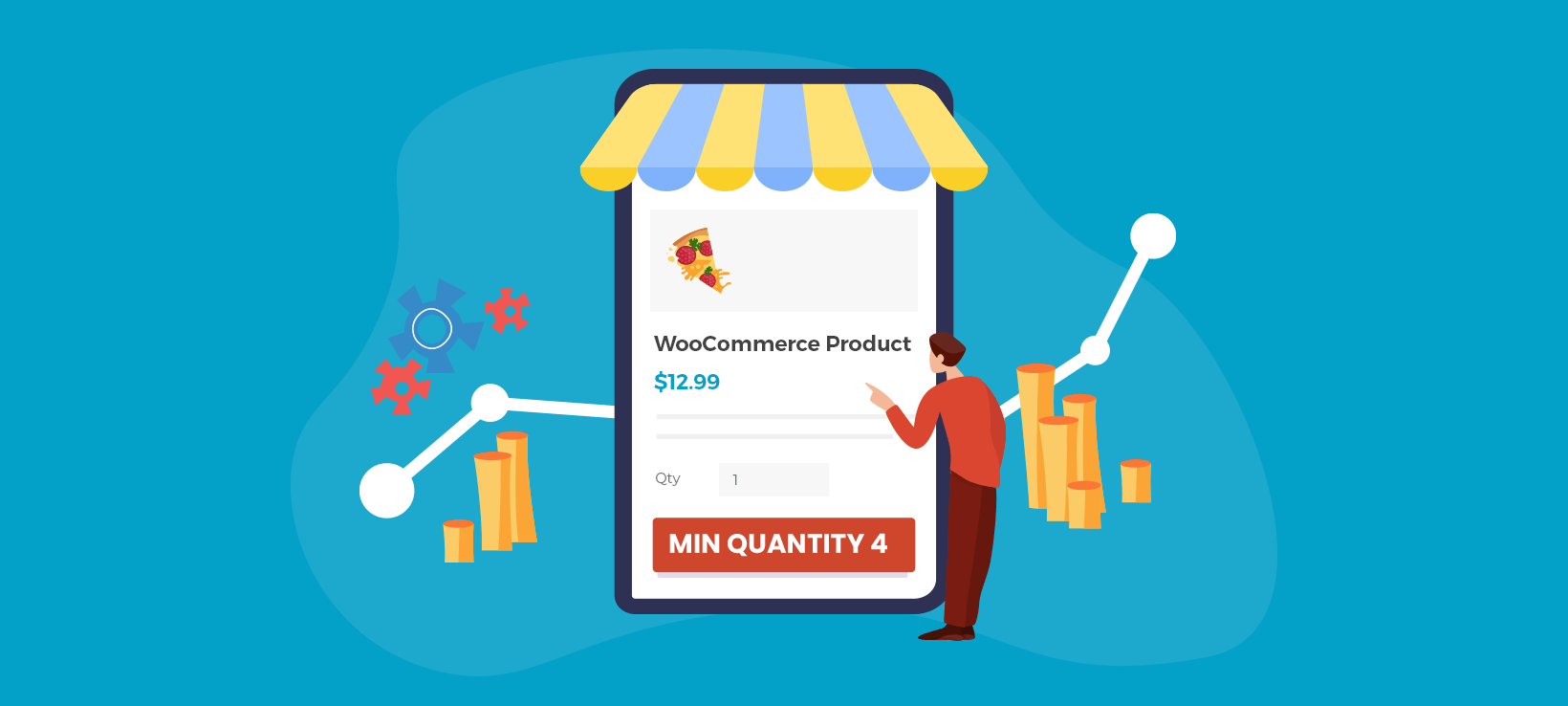
Adding minimum and maximum quantity rules to WooCommerce ensures that every sale is both profitable and manageable for your online store. This article will introduce you to the best min max quantity WooCommerce plugin, and show you how to set it up in just a few minutes.
When you use WooCommerce as it comes, your customers can order as few - or as many - of each product as they like. There are no min or max quantity restrictions. This can cause several problems for your company, including:
- Unprofitable orders - customers can place tiny orders that are not cost-effective to fulfil.
- Products with low profit margins - some products are only profitable when ordered in larger quantities, otherwise you lose money.
- Capacity issues - you risk receiving huge orders that are too big for your warehouse to manage.
- Packaging difficulties - some products can only be packaged efficiently in certain quantity groupings, e.g. in packs of 4.
- Lack of flexibility - you may have different operational processes for certain user groups, such as wholesale buyers. A one-size-fits-all quantity setting makes this difficult.
The WooCommerce Quantity Manager plugin solves all these problems and more. Unlike other min max quantity WooCommerce plugins, it's easy to use and 100% flexible. It gives you total control over the product quantities in your store, without slowing it down.
6 reasons why a WooCommerce minimum and maximum quantity plugin can increase profits
Before we start, let's look at why you might need a WooCommerce min max quantity plugin in the first place. I firmly believe that you should only install plugins that you have a genuine need for. Ask yourself: "Will this plugin make my store more profitable or easier to manage?"
The best min max quantity WooCommerce plugin lets you answer "Yes" to both questions. Here are 6 reasons why it can increase your profits while making your store easier to manage:
Reason #1 - Use the woocommerce min max quantity to increase profits
Many WooCommerce orders are only profitable if they're over a certain minimum and maximum quantity or minimum order value.
This is a big problem if you sell low value products and expect customers to order multiple items at once. For example, an online restaurant ordering system assumes that people will order an entire meal. If someone orders an individual drink or one small side salad then it's not worth preparing and packing their order.
A minimum order WooCommerce plugin lets you guarantee that every order is profitable. Simply set the min/max quantity or value. Customers will be encouraged to continue adding to their order until they can check out at a level that is profitable for you.
Reason #2 - Set a WooCommerce minimum quantity per product to make every product profitable
At the same time, you might have certain products that are only profitable when ordered in bigger quantities. In this case, setting a minimum quantity isn't much use because the issue relates to each product, rather than the overall order value.
Instead, you need a plugin that lets you set the WooCommerce product minimum quantity.
WooCommerce Quantity Manager lets you set a minimum quantity for categories, products or variations. This gives you more flexibility and saves you time. For example, if you have a hardware store with a 'Nails and screws' category then you can set a minimum quantity for this whole category, instead of having to edit each individual product.
Setting minimum quantities helps you make sure that every product is sold for a suitable profit margin.
Reason #3 - Use WooCommerce max quantity to manage capacity and keep your orders manageable
Every business loves to receive big orders, but there is a limit. Realistically, you can only handle orders that your team and warehouse have the capacity to manage. If you receive orders that you can't handle then you risk letting down customers and damaging your reputation.
Of course, WooCommerce itself has stock management features. These manage your inventory and make sure you only sell items that you actually have in stock. However, this only applies to one product at a time. Stock management won't prevent you from receiving unmanageably large orders.
The solution is to use a WooCommerce max quantity plugin such as Quantity Manager. Use it to set a max quantity for entire orders, orders from a specific category, or for each individual product or variation. Depending on your store's needs and capacity issues, you can set a maximum quantity or maximum order value.
This ensures that your store has the capacity to handle every order and won’t get overwhelmed. Your staff and customers will thank you for it!
Reason #4 - Use default quantities to increase your average order value
WooCommerce min and max quantity rules physically control the quantity that customers can order. You can also benefit from a more gentle approach.
The WooCommerce Quantity Manager plugin lets you change the default quantity which appears on the quantity field for each product. While this doesn't control what customers can buy, it's a powerful way to nudge them in the right direction.
The default quantity in WooCommerce itself is 1. Unconsciously, this suggests that it's normal to buy 1 of each product. But you want customers to buy more than 1!
Increase the default quantity or set it to zero. Either way, you're creating the impression that it's normal to buy larger quantities of your products. It's a great way of increasing the average order value in WooCommerce!
Reason #5 - Use WooCommerce quantity increments to improve operational efficiency
In WooCommerce itself, customers can select quantities in increments of 1. This means that they can order in quantities or 1, 2, 3, 4, and so on.
The Quantity Manager plugin lets you change the quantity step value to anything you like - either globally, or per product/category/variation. This works nicely alongside your WooCommerce min max quantity rules to make your warehousing, packaging and delivery more profitable.
For example, you might sell a certain type of product in pallets or boxes that can fit 4 products. If the customer orders a quantity that is not a multiple of 4 then you're paying to ship empty space. This reduces your profits, as well as increasing the carbon footprint. Instead, you can set the quantity increment to 4 and ensure that customers order in groupings of 4.
Quantity increments also help to increase profits if you have a custom manufacturing process and your order quantities need to fit with this.
Reason #6 - Set min and max quantity rules for certain user groups
So far, we've assumed that all your customers will have the same quantity requirements. That's not necessarily the case.
If you have a multi-purpose store that sells to different types of customers, then you might want to set WooCommerce min and max quantities for certain groups only. For example, if you have a B2B wholesale store (e.g. using the WooCommerce Wholesale Pro plugin) then you might want to set a WooCommerce minimum quantity for wholesale buyers only. Wholesale users often have different terms, such as bulk shipping options, which aren't available to normal customers. As a result, it makes sense to set quantity minimums for them without affecting other customers.
You can easily do this with the WooCommerce Quantity Manager plugin. Just choose which user role(s) your minimum maximum quantity rules will apply to.
Why WooCommerce Quantity Manager is the best min max quantity WooCommerce plugin

As you can see, setting minimum and maximum quantity rules can increase both profitability and efficiency. The next step is to choose which WooCommerce order quantity plugin to use.
We built WooCommerce Quantity Manager after struggling with other WooCommerce min max quantity plugins. The problems we found were:
- Performance problems - particularly slowing down the cart page.
- Unhelpful errors - some of the error messages were quite rude and abrupt, telling the customer that there is a problem without explaining what they need to change in order to check out.
- Multiple errors showing at once - some plugins display multiple errors at once if a customer is breaking more than one quantity rule. These can fill up the page and look terrible unless the min max quantity plugin makes an effort to combine and rationalize them.
- Confusing logic - A quantity plugin for WooCommerce needs to be written very carefully to achieve the right logic between the different levels of quantity rule. For example, global quantity rules should override category rules, which should override product and variation rules. Otherwise, things get confusing for the store owner and their customers.
- Missing options - Most WooCommerce min/max quantity plugins focus on specific features only, so you're left with gaps in functionality. For example, a minimum order WooCommerce plugin might let you set the minimum quantity and value, without offering product minimum quantities or features such as quantity increments and defaults. To get the full business benefits, you need a fully featured WooCommerce quantity plugin that controls all aspects of your product quantities.
We decided to build a plugin that solves all these problems. WooCommerce Quantity Manager was the result.
Which industries need minimum and maximum quantities?
Before we get to the setup tutorial, let's look at some specific industries that can benefit from WooCommerce min max quantities.
WooCommerce wholesale stores with bulk ordering
B2B sales are all about buying in bulk. After all, wholesale buyers are selling on your products to their own customers. As a result, it makes sense to set a WooCommerce minimum quantity per product. This ensures that your store is only used for bulk buying.
If you run a public store alongside a wholesale area, then the 'User Role' feature in the WooCommerce quantity plugin lets you add minimum rules for B2B users only.
If you only sell in bulk then quantity groupings can also be helpful. These lets you set large step values between quantity options. For example, customers might be able to purchase in groups of 5, 10, and so on.
Restaurants selling meal deals
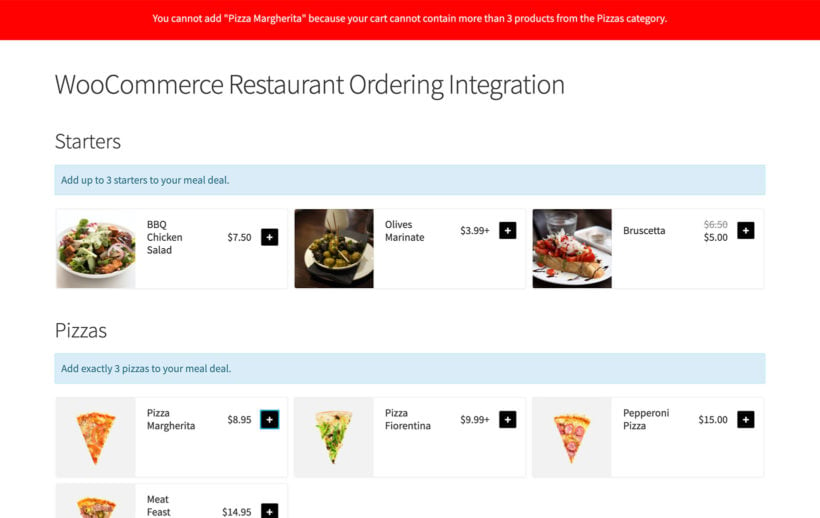
Lots of restaurants use our WooCommerce Restaurant Ordering plugin alongside Quantity Manager to sell meal deals.
They might create a fixed price menu 'product' and then add all the food options as products with the price set to 0.00. To build their meal deal, customers must order the correct number of items from each category. For example, a meal deal might contain up to 2 starters, 2 main courses and up to $15 worth of side dishes or desserts. You can easily add these min max quantity rules and values with the WooCommerce min max quantity plugin.
Even if your restaurant doesn't sell meal deals, it might still need a minimum or maximum quantity. For instance, this is useful if you offer free delivery. Use a WooCommerce minimum quantity to ensure that all overs are expensive enough to justify the delivery cost.
Event tickets

Event tickets often need to be sold in certain groupings based on the layout of the venue. You might also want to force people to buy at least 2 tickets at a time. This ensures that you fill each part of the venue, with no awkward empty seats.
For example, let's say that you're selling tickets to events. Create a different variation for each type of seat. Add quantity groupings to force customers to buy them in pairs, or to sell an entire row together.
You can also set the default ticket number to 0. This is much better for selling events than the usual default of 1. That's because customers can make a fresh choice of how many tickets to buy, instead of assuming that they will buy one at a time.
Selling WooCommerce products in pairs
If you are displaying prices of individual items which are only available in pairs, then quantity increments are the perfect solution. Examples of this might include 'Mummy and Daughter' t-shirts, sets of chairs, sets of drinks glasses or place mats.
Your products will appear to be better value if you display the price per item. However, if it's not possible to buy items individually then you need to set quantity groupings.
Product bundles
If you're selling 'build your own' product bundles, such as gift baskets, then it's important to add min max quantity rules to WooCommerce.
Let customers build a product bundle by selecting the correct number of items from each category. This might include custom gift baskets, cosmetics sets, food boxes, and so on.
For example, you might instruct customers to choose 1 item from the shampoo category, 1 from the conditioner category and 2 from the make-up category. Use WooCommerce minimum and maximum quantity rules to prevent mistakes.
Seasonal sales
When you run a sale, it's important to make sure that everyone can access the discounts. Otherwise, a small number of customers can buy all your discounted stock before anyone else gets a chance.
During sale periods, set a maximum order quantity in WooCommerce. This prevents abuse of the sale prices and ensure that lots of different customers can benefit from the price reduction. This is particularly important for major sales such as Black Friday.
In-demand products
For the same reasons, you can ensure that popular items are shared fairly between customers. Use a WooCommerce max quantity per product to limit the number of in-demand items that each customer can buy. This helps to keep more customers happy overall.
This is also useful for products with low stock levels, preventing just one customer from buying all the remaining stock.
Now you know how you can benefit from minimum and maximum quantities, and which plugin to use. The next step is to install it. I'll show you how in the next section.
Tutorial: How to add WooCommerce min and max quantities
Ok, now we've reached the tutorial section of this article. The min max quantity WooCommerce plugin is really easy to use, and you can start adding minimums and maximums in minutes.
The main thing to think about is where to add the quantity rules:
- You can set them globally so that they apply to the entire order.
- There are category-level quantity rules which force customers to buy a min or max number of products from specific categories.
- It's also possible to add min/max quantities to individual WooCommerce products and variations.
To save yourself time, I recommend adding min and max quantity rules to WooCommerce at the highest possible level. That's because you only have to set global rules in one place, whereas product-level rules need configuring for every product.
With this in mind, follow the instructions below that are most relevant to your store. You don't need to add every type of minimum and maximum quantity rule. Just add the ones you need, and ignore the rest. For example, it's fine to set a minimum quantity without adding a max quantity. The WooCommerce min/max quantity plugin will cleverly apply the correct rule to each product, without any conflicts.
Create a global WooCommerce minimum and maximum order quantity
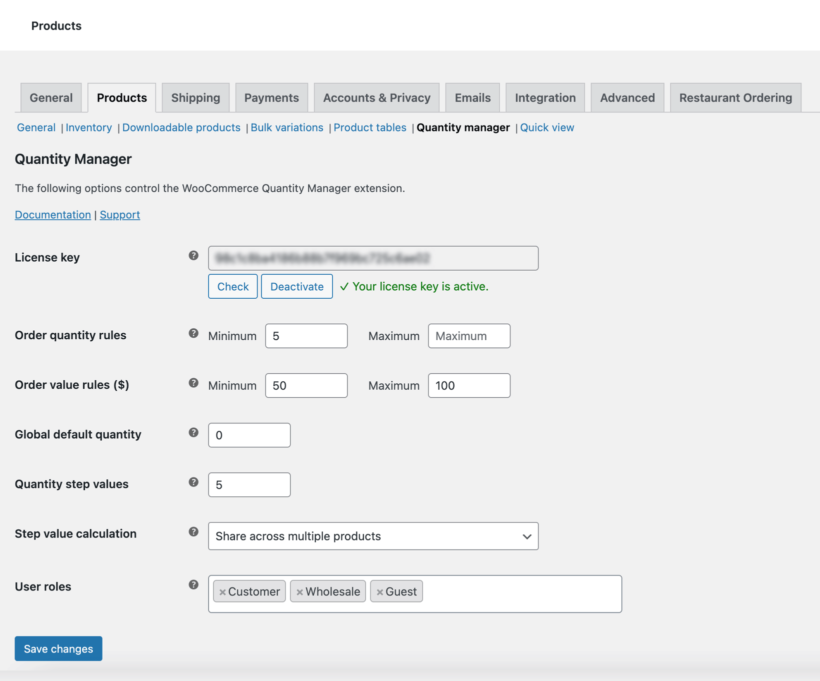
- Install the WooCommerce Quantity Manager plugin on your WordPress website.
- In the WP admin, go to WooCommerce → Settings → Products → Quantity manager.
- Set whichever global quantity rules you require, ignoring the ones you don't need. The choices are:
- WooCommerce minimum order price or quantity value.
- WooCommerce max quantity or order value.
- Quantity step value.
- Default quantity.
- You can also choose which user roles the min max quantity rules in your store will apply to.
Add category min max quantity rules to WooCommerce
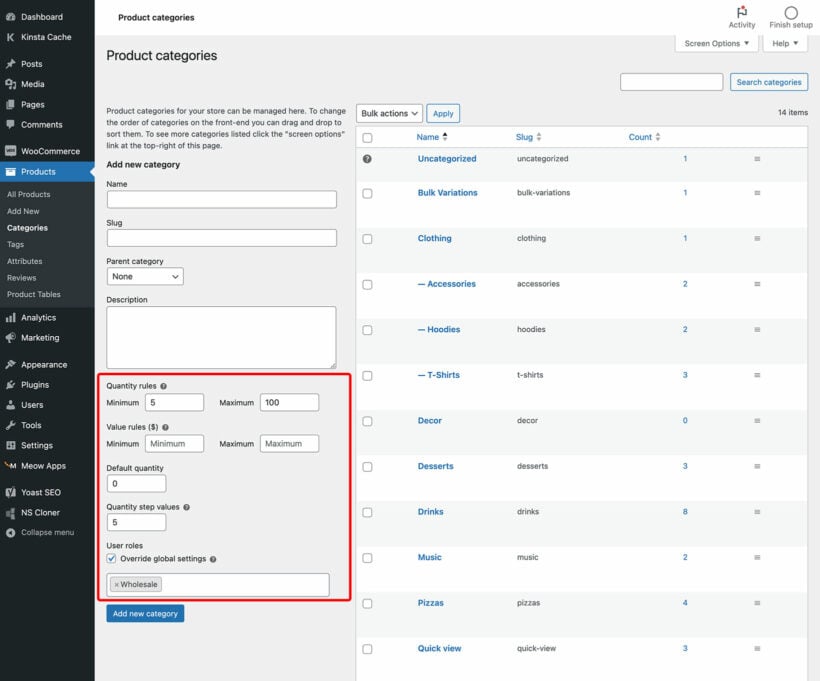
Do this if you want the quantity rules to be shared across all products in a specific category, instead of the entire order. For example, a restaurant creating meal deals should set min and max quantities or values for the starters category, the main courses category, and so on.
- If you haven't already done so, install WooCommerce Quantity Manager on your WP site.
- Go to WooCommerce → Products → Categories and click to add or edit a category.
- Add a WooCommerce minimum quantity and/or WooCommerce maximum quantity for the category. Or if you prefer, then you can set min and max spend limits for the category (e.g. spend between $20 and $50).
- You can also set quantity increments and step values for the category, although these are applied to each product individually instead of being shared across the category.
Now, if a customer adds at least one product from the category to their cart, then they must meet the category quantity rules. The cart page will contain helpful notes on any changes they need to make in order to meet the rules.
Add a WooCommerce minimum/maximum quantity per product

As we saw earlier, you can also add min max quantities per product in your WooCommerce store. This means that the quantity rules will be applied to that product individually.
- Make sure WooCommerce Quantity Manager is installed and active.
- Go to WooCommerce → Products and click to edit the product that you are adding min/max quantities to.
- Scroll down to the 'Product Data' section and open the 'Inventory' tab.
- Add a WooCommerce minimum quantity per product, a maximum quantity, or a min/max value that the customer must spend when they buy this product.
- As always, you can also set a quantity step value and default starting value.
Add min and max quantity rules to individual variations
The above instructions for adding min/max quantities to specific products work for simple or variable products. If you add product-level rules for variable products then they will be shared across all the variations for that product. For example, if there's a per-product minimum quantity of 10 then customers can mix and match variations until there are at least 10 in the cart.
If you want to set min and max quantity rules on each variation individually, then you can do this. Instead of setting the rule in the 'Inventory' tab, go to the 'Variations' tab and click to edit each variation. You'll see min/max quantity fields for the variation here.
Using quantity minimums and maximums with other plugins
One of the best things about the Quantity Manager plugin is that it works with the native WooCommerce quantity field. It also uses native WooCommerce errors to advise customers how to meet the min/max quantity rules. This makes it compatible with a wide range of other plugins.
Here are some examples of how you can use it with other plugins to make your store even more profitable.
Create a one-page order form with quantity rules
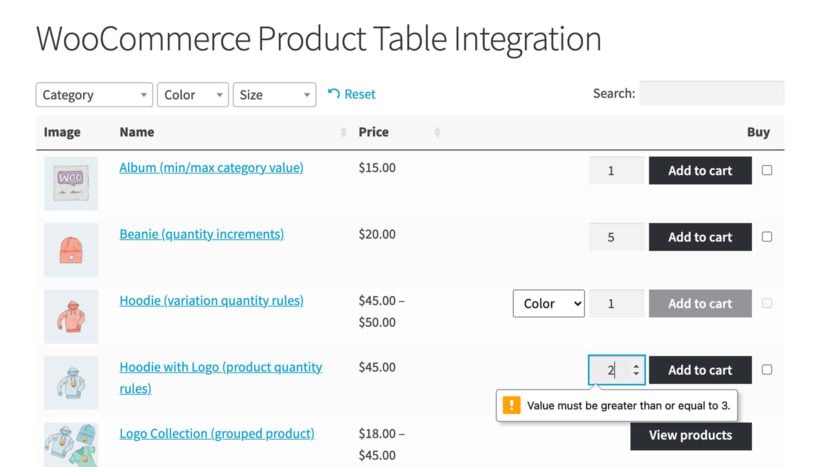
Our bestselling WooCommerce Product Table plugin lists products in a quick order form. Customers can quickly enter quantities, choose variations and add multiple products to the cart at once.
Use it with WooCommerce Quantity Manager to add min and max quantity rules to the order form.
Add quick view lightboxes with quantity controls
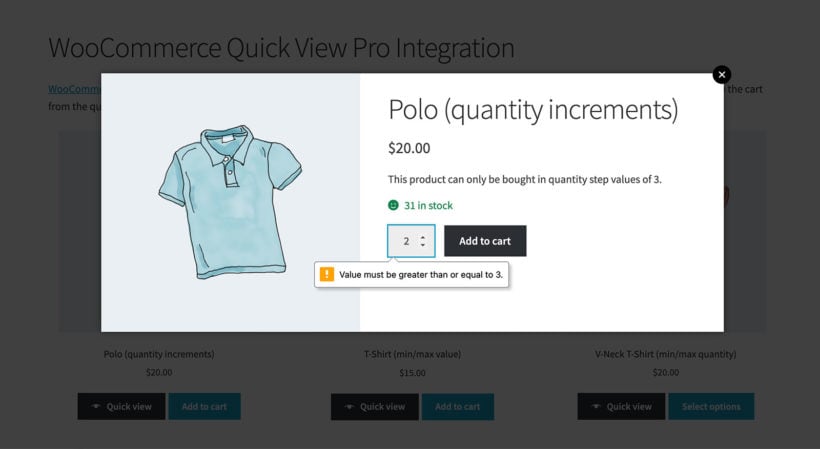
Our WooCommerce Quick View plugin saves customers time by letting them choose quantities and add to the cart away from the single product page. When you use it with WooCommerce Quick View Pro, they are forced to select the correct quantities from within the quick view lightbox.
Start adding min/max quantities to WooCommerce today!
As you can see, nearly any online store can benefit from adding min and max quantities to WooCommerce. The WooCommerce Quantity Manager plugin has everything you need to add every type of quantity rule, so install it today.
- Min/max quantities, values, step values, defaults and user role control.
- Quantity rules for entire orders, or at category/product/variation level.
- In-depth documentation and video tutorials.
- Expert support direct from the Barn2 team.
- Try it risk-free!
4 Comments
The problem with woocommerce "sold individually" is, if a product already is added to cart, and the "add to cart button" also redirects to checkout, the redirect won't work.
This happens with customers who have a slow internet connection. They press the add-to-cart button, it starts loading, they press it again and then the redirect doesn't work anymore because they already have the product in their cart with the first press.
Is there a way of fixing that, so that the redirect will still work? For example a code snippet that implements that quantity always returns to 1 on checkout?
Hi Rico,
What you describe is a limitation of WooCommerce itself. I suggest that you raise it with WooCommerce.com support for further assistance.
Should you have any other questions/concerns, kindly fill up a form at our Support Center so we can get back to you much sooner.
It's Possible To Have The "Add To Cart" Button Turn On When At Least Of A Mimimum Variable Product Is Selected When In A Single Product Page And A Table Of Products Variation Is Displayed?
Unfortunately this isn't possible - instead, an error appears if you try to add products to the cart before selecting the minimum quantity.